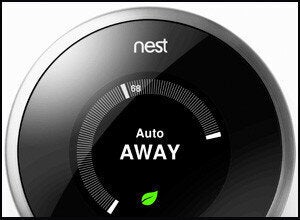
Having helped design two of the most elegant electronics in history, the iPhone and iPod, Apple alumnus Tony Fadell is now setting his sights on the least sexy device in our homes: the thermostat.
With funding from Google Ventures, among other investors, and input from Al Gore, an adviser, Fadell has created a new breed of thermostat that combines the body of a can of tuna with the brain of an iPhone.
"These are really cellphones," Fadell said of his thermostats. "These have almost all the capabilities of the iPhone."
If Apple designed a thermostat, it might look like Nest, the new heating and cooling system created by Fadell's startup of the same name.
The silver thermostat is round and squat, slightly wider than a soda can, with a black screen that glows red or blue when cooling or heating. There are no buttons, no grayish-green glow, no boxy frame and no excess numbers. The round screen displays the only temperature, a semi circle indicating the temperature range and, when in its energy-saving mode, a small green leaf.
To set the temperature, users can either press and rotate the outer ring of the device, or tap their phones: The WiFi-enabled thermostat can be programmed from anywhere in the world using an application available on iPhones, iPads and iPod touch devices, and, eventually on Android-powered gadgets as well. Users can also control Nest from the company's website by setting up an online account.
Really, however, Nest is designed to program itself.
Fadell bills Nest as the "first learning thermostat." Unlike manual or programmable thermostats, which require users to either adjust the temperature by hand or predict their future heating needs, Nest is designed to intuitively pick up on users' habits based on the temperatures they set, and anticipate cooling and heating cycles on its own. The software, which was designed by Google's former head of innovation Dr. Yoky Matsuoka, is programmed to learn from its users' schedules and continuously tweak its settings automatically.
"It learns very rapidly, sort of like a toddler," Fadell said.
Though Nest lacks the Energy Star endorsement given to products that meet the Environmental Protection Agency's energy efficiency guidelines, the product is engineered with several hardware and software features designed to reduce energy use.
To save power and costs, a "green" setting on the thermostat will nudge users just a few degrees outside of their comfort zone, with the idea that someone who prefers a room kept at 72 degrees might not notice when it's cooled to just 73 or 74 degrees.
Nest also has a built-in activity sensor that it can use to turn itself off if it does not detect motion for an extended period of time. Additionally, the device can be password protected to keep energy hogs from tweaking the temperature.
Though Nest is far more than the average thermostat, at the end of the day it's still a thermostat, devices that are, by Fadell's own admission, "unloved." Fadell is betting that he can use tech to transform the thermostat from something that is purely functional and largely ignored to a domestic status symbol.
"The goal of the design is to be a jewel on the wall so people are proud of it," Fadell said.
But consumers aren't yet in the habit of seeking out luxury heating control systems, nor are they used to spending north of $200 for such a device. Nest costs $249, up to 10 times more than other programmable thermostats currently on offer (albeit with more limited capabilities), and $50 more than an iPod touch.
Nest will be available for pre-order from Nest.com and Best Buy starting Oct. 25 and will be in stores by mid-November. Though Best Buy's Geek Squad can help homeowners install the thermostat, Fadell estimates that individuals can do it themselves in 20 minutes or less.
"It's low voltage," he added. "So you can't really shock yourself."

